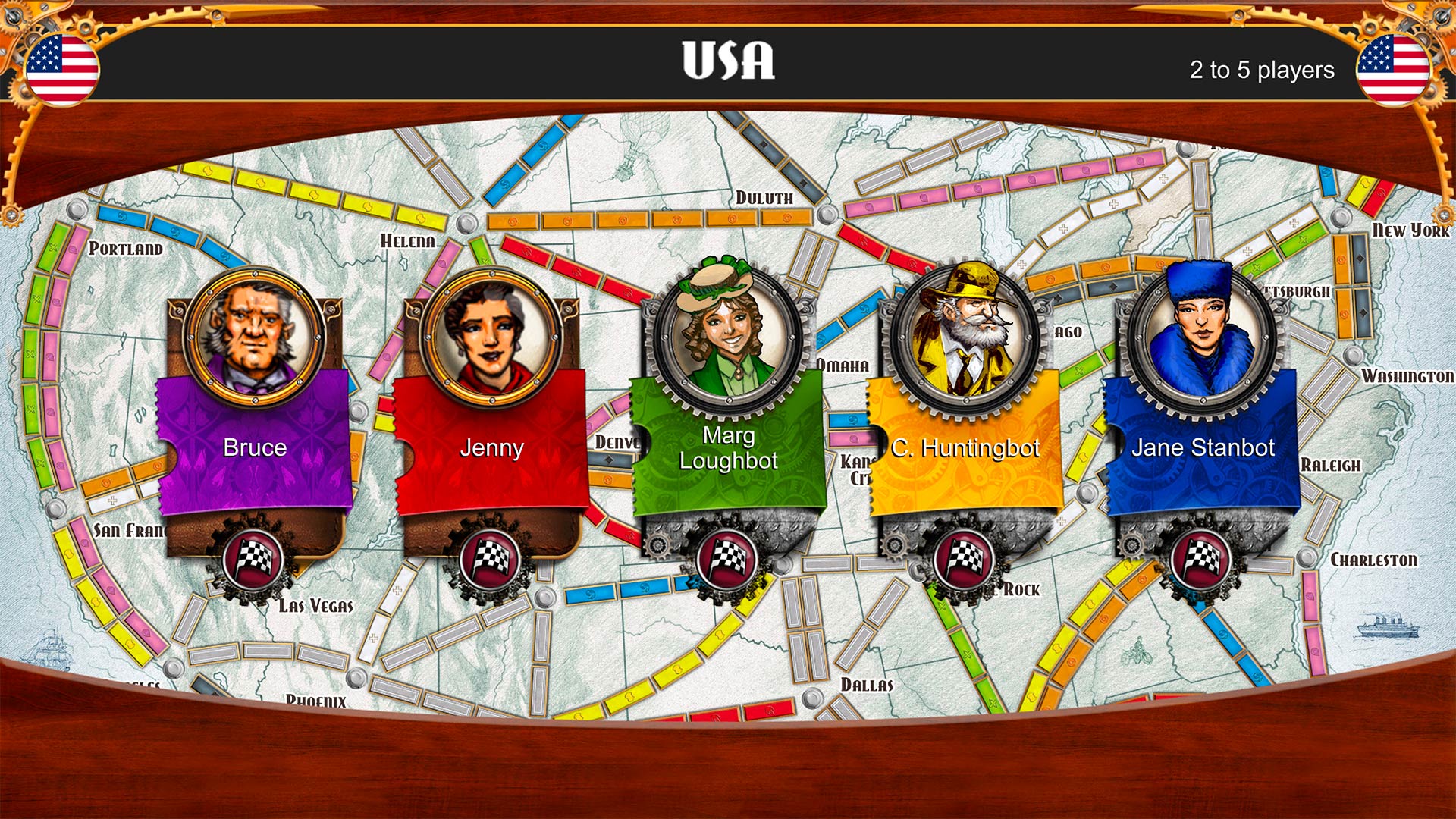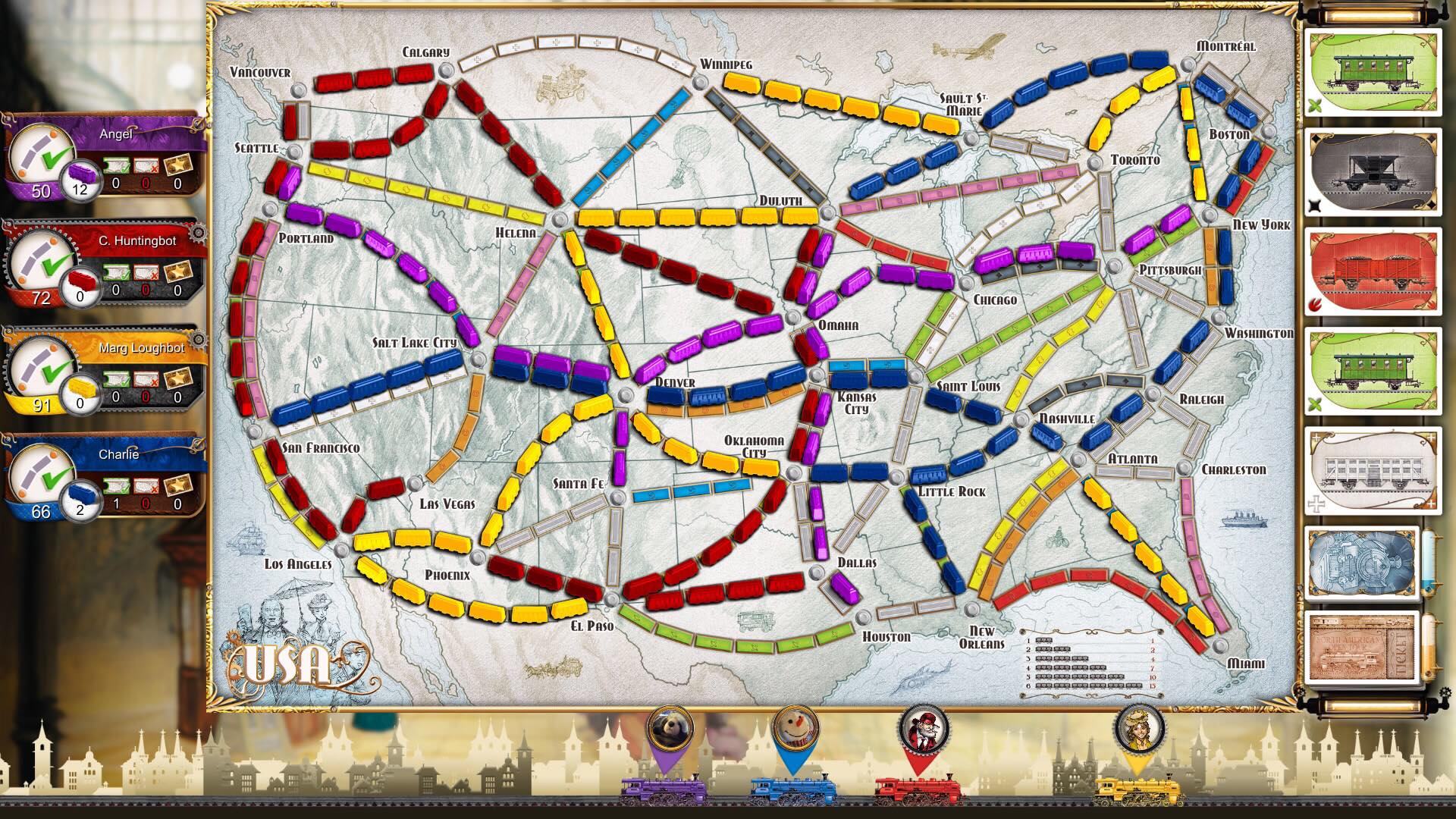
I grew up with video games, but a few years ago I discovered a love of tabletop gaming that comes close to rivaling my love of video games. Between listening to The Dice Tower podcast and watching Wil Wheaton’s web series TableTop, I discovered countless amazing tabletop games. I quickly learned that I lacked the required space for many of them: a bunch of tabletop games need a lot of flat space that’s accessible to everyone. Tabletop games are also pricey and often don’t go on the same kinds of sales that we video gamers are used to. Finally, tabletop games often have lots of strict rules to follow. I don’t know about you, but I certainly don’t consider perusing instruction manuals every time we can’t remember how a rule works a good time!
Luckily, video and tabletop games often wed and have glorious babies. Ticket to Ride, one of the tabletop games I’ve heard of the most, is one such offspring. In this case, the little bundle of joy comes in the form of a PlayLink title on PS4, letting 1-5 human players compete using their iOS or Android devices, filling in as many spots as they’d like with AI players.
For those not familiar with the rules, Ticket to Ride is a board game in which players are tasked with building railway routes. At the beginning of the game you draw three destination tickets to choose from. These present you with two points to connect on the map, such as from Vancouver to New York. Once everyone has chosen their destination tickets, players are given the choice of four possible actions on their turn: draw two train cards, draw one locomotive (if one is face-up), draw more destination tickets, or claim a route.

The main goal of the game is to draw the train cards you need to claim routes and complete your destination tickets. Routes are various lengths and have differing requirements to complete. As you can see in the screenshot above (taken from the app), claiming a route from Portland to Sault St. Marie has numerous possibilities, but if you go straight north from Portland (in the upper-left corner) and then follow the top of the map you’ll have three gray routes (two that are only one space each and one that’s three spaces), a 6-space white route, and a 6-space gray route. Gray routes allow you to use any color train cards you’d like (but you have to use multiples of the same color; the 3-space gray route requires 3 of the same color, you can’t use a green, red, and blue), but any other routes require that number of that color. Locomotives are wild cards and can be used for anything. Finally, only one player can claim a route, so claiming them quickly is important! 4 and 5 player games let two players claim any route that has two colors side-by-side (such as the two single-space gray routes from the example before), but even then you have additional players that can claim them first, and many of the inner routes can still only be claimed by one player. As a game goes on, cities and entire portions of the map may become entirely inaccessible!
You’ll get points for each route you claim, and the longer the route is the bigger the bonus (a 1-space route is only 1 point, whereas a 6-space route is 15 points!). Destination tickets each come with a point value, and while completing them gives you that many points, failing to complete them reduces your score by that much! Also, any time you choose to draw destination tickets, you’re given a choice of three but you HAVE to choose at least one. This makes drawing them very dangerous toward the end of the game as you may end up with three destination options you simply can’t complete. On the other hand, toward the end of the game your route will probably be huge, and it may take only a turn or two to complete new destination tickets. There have even been times that we’ve drawn destination tickets we already had completed, meaning we gained a big bonus just for drawing new ones!
Players begin with 45 trains. Each time a route is claimed, they use up that number of trains. The end of the game triggers when any player has two or less trains left. Once this happens, each player (including the player who triggered the end of the game) gets one last turn before scores are tabulated. The game goes from player to player, highlighting their destination ticket routes and giving them the bonus points for them (or penalizing them if a ticket isn’t complete). After this is completed for all the players, the game calculates who has the longest continuous path and gives them 10 bonus points.
After playing around 20 total games I can see why Ticket to Ride is a classic. The game is very well-balanced, and with players taking only one turn per round, the game is very fast-paced. Using your phone or tablet to play means it’s super easy to keep your destinations and train cards a secret, probably even easier than the actual tabletop game since there were times I had 15-25 train cards in my hand at once plus up to 8 or 9 destination tickets. If you’ve ever played UNO and felt your hand cramp up after drawing a bunch of cards, you’ll appreciate that they’re all sorted, counted, and nicely displayed in a device you probably use every day! The app also does a terrific job of showing you your destination cities on the map so you aren’t repeatedly trying to remember where you’re trying to go.
I tried games ranging from 2-5 players using bots to fill in the extra spots, and the game was fun in every variation for different reasons. When just my gal and I play together we actually make sure not to get in each other’s way, opting to make some super awesome train routes and get loads of points. Three-player games led to us all frequently getting in each other’s way, and four-player games were still rather hectic in the middle of the US, but the addition of routes that allow two players to claim them helped. Five-player games were just ridiculous, chaotic fun! There were routes everywhere, people battling to get to various locations, and it quickly became possible for two or three players to trigger the last turn at any moment. It was wild how many of us took point deductions for not completing tickets! Bots don’t have customizable difficulty settings, but I like that they’re a good challenge without feeling like they’re cheating or impossible to defeat.

While Ticket to Ride is a terrific game, and the app has lots of positives to it, it’s also the only thing keeping this game from perfection. Taking your photo for the game is a bit hit-and-miss: sometimes it worked fine, sometimes it rotated the image for some unknown reason, and other times it just didn’t save the photo at all. The game does a perfect job of saving your name and color choice between sessions, but for some reason you’ll need to take a new photo each time, including back-to-back games. Each color comes with a single stock image, but they aren’t interchangeable; my gal’s favorite color is purple, but she sure didn’t want to play as some old dude!
In addition to photos, claiming a route requires you to swipe the proper train cards up to whatever route you want to play them on and then let go. Because they’re nestled at the bottom of the screen, I often grabbed the phone menu from the bottom of the screen rather than the cards. Also, while it’s nice that the game zooms in when you’re hovering your finger over the routes, sometimes the zoom happened exactly as one of us was letting go of the cards, and we’d accidentally claim the wrong route.
Finally, once a game ends, there’s no way to start a new game easily. I tried mashing all kinds of buttons on my PS4 controller and using every option available on the app, but eventually we realized that if we both backed out of the game in the app at the same time it would consider the game ended and start over. There’s no mention of this method in the game, and since there’s a 10 second auto-rejoin counter it’s an awkward fix.
In the end, even with these issues with the app, Ticket to Ride was a load of fun. If the game was merely decent the issues would’ve probably kept us from touching it again after I played it enough for a review, but it’s a game we find ourselves playing any time we have 15 minutes to relax. The bots all take their turns very quickly, and even when we played against three of them, they finished their turns in less than 10 seconds combined. Because the entirety of the game exists on your phone while playing, it was pretty funny being able to take the game with me into the kitchen for a snack or even to the bathroom across the house. You sure can’t do that with a tabletop game!
Note: Ticket to Ride also includes the France map. The France map is very different and much more complex. The map is also bigger and requires you to swipe around on your app to see the whole thing. The learning curve is even steeper than the base game, and we just didn’t enjoy it at all. There are numerous additional DLC to unlock other expansions, and while I was super excited to get some before I tried the France map out, I’m rather nervous to buy more when they could be equally confusing. Because the France map is entirely optional I didn’t factor it into my review score of the game.
REVIEW CODE: A complimentary Sony Playstation 4 code was provided to Bonus Stage for this review. Please send all review code enquiries to press@4gn.co.uk.
Subscribe to our mailing list
Get the latest game reviews, news, features, and more straight to your inbox
Thank you for subscribing to Bonus Stage.
Something went wrong.
Ticket to Ride Review
-
Gameplay - 8/10
8/10
-
Graphics - 8/10
8/10
-
Sound - 8/10
8/10
-
Replay Value - 8/10
8/10
User Review
( votes)Overall
Summary
The classic tabletop game hits the big screen with the PS4 PlayLink. Use your phones and tablets to claim routes and build railways!






